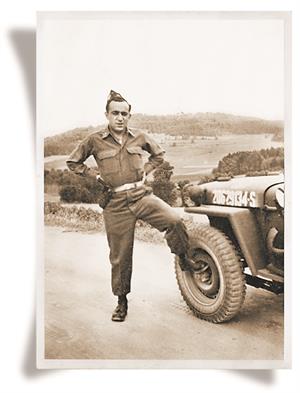
War Torn: On Owning Nazi Loot
Home renovations can unearth all sorts of treasures you forgot you even owned. Books and figurines sit on shelves, unnoticed, for years; they become part of the interior landscape, comforting in their longevity but not meaningful.
We recently redecorated my husband’s den, which was finished in a pickled wood that seemed to grow pinker with every passing year. Since a couple of decades had elapsed since the house was built, it was time for an update. And so, dusty knickknacks were removed from glass-fronted cabinets and plopped down on the living-room floor to await future placement. I took the opportunity to clean and discard. That’s when, after 22 years, I came upon relics stolen by Nazis in World War II.
There they were, in all their historic decrepitude: an intricately carved—yet chipped—porcelain statuette, a dented pewter tea service, a gold cup and saucer, authentic beer steins and platters. My husband’s father, Alfred, was born in Germany in 1918, the son of a butcher in the small town of Schermeisel, east of Berlin and now part of Poland. A Jew, he was brought to the United States by a distant family member at the age of 15, and, shortly after Hitler rose to power, he sent for his mother. Rosa arrived via Shanghai and never recovered from living under the frightful regime; in her elder years, when dementia had robbed her of rational thought, she would call us at all hours to say the Nazis were banging at her door, and we should come help—now!
Alfred joined the U.S. Army and, thanks to his fluency in German and English, was made a spy during the war. He never shared his top-secret activities on the European front, or what he saw. His one oft-told story pertained to the end of the Allied invasion, when U.S. troops who ventured into German towns and villages were ordered to the residences of each Burgermeister, or mayor, which inevitably contained valuable possessions the Nazis had looted from Jewish homes. Alfred’s commanding officer instructed the soldiers to take what they wanted, as there was no way to trace the belongings.
Eventually, the objects Alfred brought home became ours. (Children can be a handy repository for what parents either no longer want or value so much they cannot bear to give up.) I never asked for them. I never formally accepted them, though I do remember rejecting a Nazi flag and sword, which, too graphic for me, remained in the basement of Alfred and his wife, Sophia.
We displayed the pieces here and there to add a vintage quality to our decor.
As a young bride, I cared more about my new everyday pottery dishes and decorating with contrasting bath towels of green and blue. But later, the blasphemous plunder just seemed to surface, and we displayed the pieces here and there to add a vintage quality to our decor. I honestly never gave any of them a second look—until a few months ago, when the rehab of the den forced their reappearance.
A 60 Minutes report from around the same time had haunted me. It concerned the raid of a Munich apartment inhabited by Cornelius Gurlitt, then 81 and since deceased, who was hoarding more than 1,400 pieces of art by Picasso, Chagall, Matisse, and Monet, among others. The works, worth more than a billion dollars, were once the property of Gurlitt’s father, one of Hitler’s trusted art dealers. On the program, an 88-year-old blind man who left Germany on a Kindertransport described the last time he saw Max Liebermann’s famous painting Two Riders on the Beach at his uncle’s home before his father was arrested by the Nazis.
And what of my possessions, which I barely regarded these many years? Whose were they, and where did they now belong? What of the 16-inch beer stein decorated with a bearded man and a flag, on whose pewter lid is engraved, to the best of my German-English translation, “The long cycle dedicated to women and virgins, 1894”—and on whose base is carved, simply, the word “Nurmburg”? The stout pottery stein dated 1928? The large copper platter with a winged creature in the center? The squatty pewter teapot with indecipherable Russian engraving? The gilded shell-form cup and saucer, which, according to my Internet research, is French porcelain from the early 1800s? And, most mysterious, the figurine of two men wearing blindfolds and wigs crouched over two women in supplicatory poses, with only the letter “R” and the year 1762 etched into the base? Someone once cherished and showcased these stolen objets d’art, making me what? A righteous steward of valued property? Or a thief? Am I, a stranger, honoring family heirlooms or desecrating them?
One way or the other, my ownership of the items has become consequential. Keeping them felt unholy, but I had little choice. I have an obligation to those families who perished in the gas chambers to respect their property. I will not attempt to sell the pieces to a collector for fear they might fall into the hands of a neo-Nazi searching for authentic Holocaust memorabilia. Someday, a museum might be a better home, or the next generation of our family. Perhaps that was Alfred’s wish.
Before his death in 2006, Alfred asked for an American flag to be draped over his casket. We complied. He was 88, and with many of his friends long gone, the graveside service was attended mostly by close relatives. After the burial, the flag was ceremoniously folded and presented to our firstborn son, his oldest grandchild.
Alfred left this world as a war hero, a loyal American. It is too late to discover the truths he witnessed firsthand, the awful stories he did not wish to share. Instead, he left behind remnants of his past—and those of others we will never know. In turn, we—his family—will not forget.
deborah@emmis.com
Illustration by Andrea Eberbach
This column appeared in the August 2014 issue.





